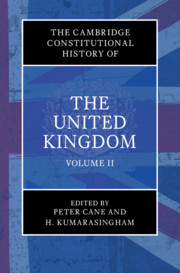Book contents
- The Cambridge Constitutional History of the United Kingdom
- The Cambridge Constitutional History of the United Kingdom
- Copyright page
- Contents
- Contributors
- Editors’ Preface
- 1 The Kingdoms of Anglo-Saxon England (450–1066)
- 2 England after the Conquest
- 3 England in the Thirteenth Century
- 4 England in the Fourteenth Century
- 5 England in the Fifteenth Century
- 6 England in the Sixteenth Century
- 7 The English Constitution in the Seventeenth Century
- 8 A European Perspective
- 9 Wales before Annexation
- 10 The Scottish Constitution before 1707
- 11 The Eighteenth-Century Constitution
- 12 The Constitutional and Parliamentary History of Ireland till the Union
- 13 The United Kingdom in the Nineteenth Century
- 14 The United Kingdom in the Twentieth Century
- 15 The Twenty-First-Century Constitution
- 16 Wales since the Annexation
- 17 Scotland in the Union
- 18 Ireland in the Union
- 19 The Making of Empire
- 20 Constitution and Empire
- Index
6 - England in the Sixteenth Century
Published online by Cambridge University Press: 12 August 2023
- The Cambridge Constitutional History of the United Kingdom
- The Cambridge Constitutional History of the United Kingdom
- Copyright page
- Contents
- Contributors
- Editors’ Preface
- 1 The Kingdoms of Anglo-Saxon England (450–1066)
- 2 England after the Conquest
- 3 England in the Thirteenth Century
- 4 England in the Fourteenth Century
- 5 England in the Fifteenth Century
- 6 England in the Sixteenth Century
- 7 The English Constitution in the Seventeenth Century
- 8 A European Perspective
- 9 Wales before Annexation
- 10 The Scottish Constitution before 1707
- 11 The Eighteenth-Century Constitution
- 12 The Constitutional and Parliamentary History of Ireland till the Union
- 13 The United Kingdom in the Nineteenth Century
- 14 The United Kingdom in the Twentieth Century
- 15 The Twenty-First-Century Constitution
- 16 Wales since the Annexation
- 17 Scotland in the Union
- 18 Ireland in the Union
- 19 The Making of Empire
- 20 Constitution and Empire
- Index
Summary
Among the first historical writers to reflect on the long sixteenth century (1485–1603), Sir Francis Bacon marvelled at the dynastic fortunes of the Tudor monarchs. Henry VII had ridden from distant exile to win his throne at Bosworth Field (1485) yet his son Henry VIII was a king ‘absolute in the sovereignty’. Then came the reigns of ‘a king in minority; of a queen married to a foreigner; and lastly of a queen that hath governed without the help either of a marriage, or of any mighty man of her blood’.1 These circumstances – a bloody usurpation, the rule of a minor and then by females – seemed perilous to contemporary observers. Contested successions and vulnerable rulers had led to the Wars of the Roses (1455–1485). Even the death of the childless Elizabeth I raised fears about civil war. Consequently, James VI and I’s peaceful accession to the English throne in 1603 signalled a remarkable achievement. After the tumults of the fifteenth century the Tudors had successfully defended their dynastic claims and reconstituted royal authority.
Keywords
- Type
- Chapter
- Information
- The Cambridge Constitutional History of the United Kingdom , pp. 131 - 159Publisher: Cambridge University PressPrint publication year: 2023



